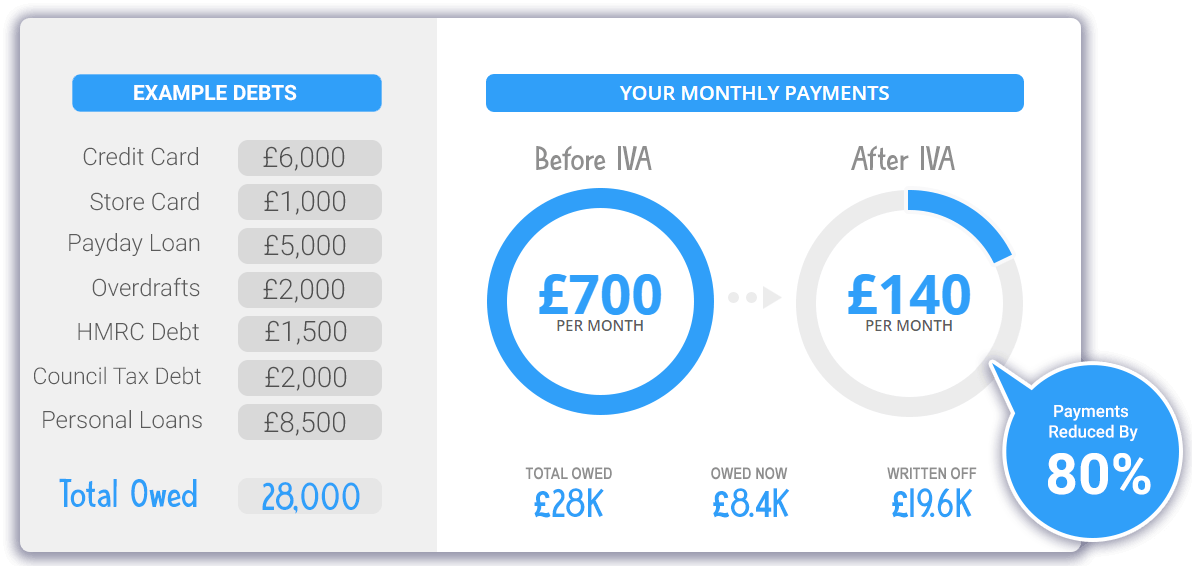
Jubilee can help you get a £10,000 loan to pay off your debts:
- Specialist direct lender that only offers loans for debt consolidation
- Fast and Free desktop based home valuation with no appointments necessary
- Loan to value up to 90%
- No lender, broker or advisor fees
- A decision in principle based on a soft credit search
- Broad tolerance of credit history issues
- 7.21% capped interest rate that will go down if BOE base rates reduce over time
- Flexible loan terms
- Speedy completions often in as little as two weeks
- Only available to people who have an existing mortgage
- One penalty-free payment holiday per year (2 weeks notice required)
- No valuation penalty is applied to flats and other leasehold property titles
- No upper age limit
- Further future advances subject to recent valuation
"*" indicates required fields
Do you owe £10,000 and are struggling to repay your outstanding debt?
It may be stressful having to continually receive phone calls, emails, and letters from your creditors if you cannot make repayments on time. The good news is, for those who are 10000 in debt, a full suite of debt solutions is available to you, including Debt Relief Orders which are not available to those who owe more.
The options to get your finances back under control and become debt-free are listed below.
Do you have 10K In Debt? Take our 60-Second Debt Calculator Test. It can help you clear up to 90% of your Debts.
What Are the Difficulties of Trying to Reduce 10K of Debt?
The monthly repayments will be substantial if you have racked up £10k in debt. You will not get out of debt if you can only make the minimum monthly repayment. Instead, the interest on the balance is allowing debts to creep higher.
£10 000 Credit Card Debt
Unsecured personal loans typically have an interest rate below 10%, but credit cards can have an interest rate well above 20%. If all your outstanding debts are card debt, then £10,000 will become a substantial burden, especially if you cannot repay the monthly principal.
How An IVA Could Radically Reduce Your Debts

What Are the Immediate Steps to Take If You Are Unable to Pay off Your Debts?
It will help if you get professional debt advice as soon as you feel you can no longer pay back your outstanding debts. Citizens Advice, the National Debt Helpline, and a reputable debt management company are three avenues open to you.
A good debt adviser will be able to offer the following options:
- Recommend ways to deal with debts you may not have thought existed.
- Offer guidance on better methods to manage your income and finances.
- Speak to you non-judgmentally so you will feel better and not worst about your situation.
- Treat all interactions with a high degree of confidentiality.
Are There Any Money Management Techniques That May Work?
Two proven techniques for managing your debts may effectively bring your finances back under control before you need to consider a full debt management solution.
The avalanche method:
Also known as debt stacking, the avalanche method works by paying off your debts, starting with the highest interest rate first and is a 3-step method:
- Make a minimum payment on all outstanding balances.
- Pay additional money to the balance incurring the highest interest rate.
- When the debt with the highest rate is repaid, start repaying the debt with the next highest interest rate.
As you move to pay off each outstanding debt, you free up spare funds to channel into the next debt, a strategy proven to pay off your creditors quickly.
The snowball method:
With the snowball method, you start repaying the smallest debts and work your way up to paying off the largest.
As with the avalanche method, there are three steps:
- Make a minimum payment on every outstanding debt balance.
- Put spare money into paying off the smallest creditor balance.
- Once the smallest balance is repaid work on paying off the next smallest debt until you finally reach the largest account balance.
Lower Monthly Payments & Write Off Up To 90% Of Your Debt – 60-second Form
What Solutions Are Available for Me to Pay Off £10000 in Debt?
The snowball and avalanche money management techniques can help you pay off your debts. Unfortunately, proven systems do not always work; if this is the case for you, a structured debt solution may be the only avenue to avoid defaulting on debts of £10,000.
Debt Relief Order (DRO)
If you have less than £20,000 in outstanding debts and less than £1,000 in assets, a Debt Relief Order or DRO might be a viable solution for you. DROs are available in England, Northern Ireland, and Wales (not Scotland). If they think you qualify for a DRO, your Debt Adviser will send in your application to the official receiver, a civil servant at the Insolvency Service. An official receiver looks at your financial circumstances before deciding whether to grant a DRO.
If granted, a DRO freezes debt payments and interest for 12 months. At the end of the DRO, the list of qualifying debts is discharged, meaning they do not need to be repaid.
The benefits of a DRO:
- Once a DRO is in place, the official receiver will tell all the creditors that they cannot ask you to repay outstanding debts for 12 months, after which they are written off.
- A DRO can be a lower-cost alternative to declaring bankruptcy. A DRO costs £90 to put in place, whereas bankruptcy costs £680 before you can apply.
- Despite a Debt Relief Order being a formal agreement, you are not required to appear in a county court.
The drawback of putting a DRO in place:
Not all types of debts can be placed in a DRO and those you still need to pay will include:
- Student Loans
- Child maintenance
- Secured loans (debts held against an asset you own)
- Debts incurred after a DRO is in place.
- Outstanding TV licence fees
- You cannot take out more than £500 without advising a lender that you have a DRO in place.
- You cannot operate as a company director.
- Starting or managing a company without the court’s permission is not permitted.
- Your name will appear on the Individual Insolvency Register, which is available to the public and negatively impacts your credit rating.
- Breaking the DRO conditions is a criminal offence, and you could face prosecution or a bankruptcy order if you do so.
DCL – Debt Consolidation Loans
There are two styles of debt consolidation loan, also known as DCL, available. One type is for secured debts, and the other is for unsecured debts. Secured debts are borrowings that are secured against an asset such as a car or a property. Unsecured debts do not pledge against an asset.
In a DCL, the idea is to reduce monthly repayments through a lower interest rate and an extended term. This is achieved by amalgamating various individual loans into a single manageable payment. To do this, a DCL requires you to take out new credit with a provider that pays off all the outstanding individual balances. As with other solutions, this option has advantages and disadvantages.
Benefits of a DCL:
There are two key benefits of a DCL:
- You will only owe money to a single lender, reducing the stress of dealing with multiple creditors simultaneously.
- The monthly payments will be lower, making repayments more manageable and improving your quality of life as you work towards becoming debt-free.
Drawbacks of a DCL:
- A DCL involves fees and additional costs to implement, which may initially make your financial circumstances even more challenging.
- Your outstanding debts may take longer to pay off as often a DCL reduces monthly repayments by extending the duration of your debts.
- Depending on the duration of the credit arrangement and the interest rate, you may end up paying more over the DCL’s lifetime.
DMP Debt Management Plan
A debt management plan (DMP) is a solution provided by a DMP provider. The provider examines your financial affairs and calculates a budget that allows you to pay back your debts at a lower rate and reduce monthly payments.
If a DMP is recommended for you, the provider will contact your lenders on your behalf with a proposal. If creditors approve the debt management plan, payments will go to them through your DMP.
Benefits of a DMP:
- Only one monthly payment must be made into a DMP, and then the DMP provider will make the individual payments to all your creditors.
- The DMP provider reviews your DMP periodically so you only repay what is affordable.
- After your provider puts together a budget for your daily needs, only what remains affordable goes to your lenders.
Drawbacks of a DMP:
A DMP does have some disadvantages:
- A DMP differs from an IVA because creditors can still add interest and charges to your outstanding borrowing.
- A creditor may pursue further action to recoup their debts, including a CCJ (county court judgment).
IVA – Individual Voluntary Arrangement
An Individual Voluntary Arrangement (IVA) is a solution in which an Insolvency Practitioner (IP) proposes a viable repayment plan for your outstanding debts to creditors.
The proposal outlines:
- How much do you propose to repay as a percentage of the outstanding debts?
- A Statement of Affairs outlining your income, assets, and personal finances.
For an IVA to gain acceptance, at least 75% of the creditors must agree to the proposal application. Creditors will occasionally accept repayment for as little as 25% of any outstanding borrowing, although above 30% is more typical.
Once a proposal is approved, the IP will set up and administer the agreement on your behalf. An IVA lasts five years and involves making a monthly payment into it, which then passes through the IP to the different lenders.
The IVA is a formal agreement agreed upon in a court of law, meaning creditors cannot act against you. The debtor must adhere to the IVA terms. Otherwise, an IP can recommend that bankruptcy proceedings take place.
Benefits of an IVA:
- As soon as you enter an IVA, stressful calls from lenders will end as they can no longer contact you directly. All correspondence must go through the IP who handles the day-to-day administration of your plan.
- Entering an IVA does not restrict the type of employment you can take up. You can still work in more financially sensitive sectors, such as the civil service or the finance industry. However, if you take another path, such as bankruptcy, you may be unable to work in specific sectors.
- Neither the IP nor creditors want to see an IVA fail. The proposal agreed will make monthly payments affordable, allowing the debtor to maintain enough income to pay for daily living expenses and bills.
Drawbacks of an IVA:
- An IVA does not include all debts as part of the plan. You cannot have secured borrowing, where assets like houses or cars are pledged in an IVA.
- As soon as you enter an IVA, you will also see a restriction in the functions you can undertake on your bank account. A debtor can access basic account functionality without access to a chequebook, overdrafts, or cards.
- An IVA is a formal agreement legally binding in a court of law. It is subject to an annual review throughout the plan, and if it is shown that you can pay more at the review, you will be obliged to do so.
Bankruptcy
Bankruptcy is often considered the final option when trying to repay outstanding debts. Even if you do not want to apply for bankruptcy yourself, a creditor may choose to initiate bankruptcy proceedings in a court of law.
Benefits of bankruptcy:
- Once a bankruptcy order occurs, creditors cannot pursue other forms of action, including count court proceedings.
- Creditors cannot contact you, which wastes having to field stressful phone calls and emails.
- You can keep a portion of your income, allowing you to live from day to day.
Drawbacks of bankruptcy:
- If you are a declared bankrupt, you will be in a register for the public to view
- Bankruptcy may stop you from undertaking certain types of jobs, such as working as a civil servant.
- When you are bankrupt, it may prove challenging to get access to credit as your score will be adversely affected six years after a bankruptcy order.
How To Clear 10k Of Debt: Final Thoughts
Owing money can be stressful, whether from creditors always calling you or worrying about buying food and paying the rent. Whatever the reasons for owing £10,000, you must take steps immediately before your finances become uncontrollable.
The first step is to get financial advice from Citizens Advice, the National Debt Helpline, or a debt management company. With sound advice, you may be able to get your money matters back in check or be guided towards a debt solution that closely matches your circumstances.
Either way, take action to regain control of your life and become debt-free.

10k in credit card debt relief FAQs
How much money is considered in debt?
A debt-to-income ratio above 43% of your salary or income is a widely accepted and statistically proven figure. This is when a debtor starts to have trouble repaying unsecured debts and will be in too much debt, whether credit cards or loan-based debts. With rent, bills, and other monthly expenses, high debt-to-income ratios make it difficult to maintain monthly repayments.
Is it reasonable to maintain some outstanding debt?
However small, making monthly payments over a sustained period suits your credit score. Rating agencies look favourably at a record that shows regular debt repayments as it confirms that you are a reliable debtor.
Why is a credit score cleared after six years?
A credit report is a score that rates your debt repayment history, itemising all your loans and credit card accounts made to creditors in a statement. Six years is a milestone where creditors can still claim against you, so it is not erased but not accounted for from a record viewpoint.
£10000 Loan – Secured Homeowner Loans For Debt Consolidation Easy
